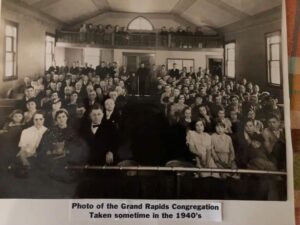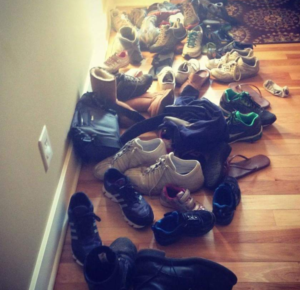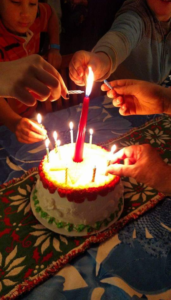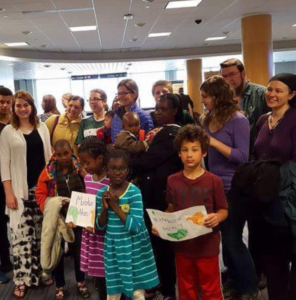
As Common Spirit Church of the Brethren celebrates 10 years of ministry in Grand Rapids, Michigan this fall, it has been interesting to compare and contrast the history of the original Grand Rapids Church of the Brethren congregation to the current one. Both churches were started by families living in the Grand Rapids area. As our group explored what kind of church we were called to start, it became clear that it wasn’t going to resemble the church that had formerly been in our city. Much time had passed since they had closed their doors and the ways to plant churches had changed. Common Spirit Church of the Brethren doesn’t own property or have a paid pastor. We don’t meet on Sunday morning and we don’t meet every week.
According to the history write-up by the Grand Rapids Church of the Brethren 50th Anniversary chairman, Russel Hartzler, the congregation began with some families who lived in the Grand Rapids area meeting in local schoolhouses. They were served by nearby ministers from other congregations. As more families settled in the city of Grand Rapids the Michigan District Mission Board decided to send a minister to the city in 1910. Over the next few years, they met in a storefront and then decided to raise money to build a meeting house of their own. It was noted that J. C. Overholt was so impressed by the location chosen for the new building near Burton Street and Division Avenue that he approached a member of the Hope Church of the Brethren to help raise $1,000. They bought 4 lots on which to build the church and parsonage.
The congregation met near Burton and Division until around 1958 when they sold the property to the Grace Calvary Congregation and bought a new site out of the city. Currently, that location is an economically depressed area with boarded-up businesses and dilapidated homes. The new location was near Kalamazoo Avenue and 44th Street in the suburb of Kentwood. They met in the Alexander Hamilton Elementary School until a parsonage could be built. The parsonage was designed for 100 people to meet in the basement and they began meeting there until the new meeting house could be built. The new building was designed by Arthur Dean, the same architect from the Church of the Brethren General Offices in Elgin, Illinois. It was noted that the new church building had moveable partitions for nine Sunday School classrooms and it was built with the idea that it would be added on to in the future. The first phase was dedicated in October of 1961 and the congregation celebrated its 50th Anniversary in October of 1963.
Throughout this written history there were many mentions of the Michigan District guiding the congregation through securing leadership and helping with funds. The congregation also borrowed $35,000 from the Brotherhood Fund for construction costs with the idea of adding on to the building after the loan was repaid. Families were called by the Michigan District Church of the Brethren and their local congregations to move to Grand Rapids to be part of the Grand Rapids Church of the Brethren. The Church of the Brethren Annual Conference, the business meeting of the denomination, met in Grand Rapids in 1955 and the Grand Rapids Church of the Brethren closed its doors sometime around 1970. I am not sure the reason.
When it was announced that the Church of the Brethren Annual Conference would once again be held in Grand Rapids, Michigan in July of 2011, there was a lot of excitement. DeVos Place Convention Center had just been built and the city visitor bureau was marketing itself as a place to host church conferences. A full two years ahead of time, my partner John Willoughby and I, along with Terri Vanas-Jones and Stephanie Vanas, all of the Hope Church of the Brethren in Freeport, Michigan, were asked to be the onsite coordinators for the conference. Being an onsite coordinator involves recruiting volunteers from the local Church of the Brethren District to help the conference run smoothly. People volunteered to run youth activities, sell meal tickets, lead service projects, and many other behind-the-scenes positions. Someone from the Michigan District designed t-shirts for the conference that said, “Meetin’ In the Mitten” and members from the Flint Church of the Brethren made wooden cutout pins in the shape of Michigan to give away to people coming to the conference. The Michigan District Church of the Brethren gave about $1,000 to help gain excitement for being the host district for the Conference.
During all the planning, the conversation about starting a new Church of the Brethren in Grand Rapids was coming up more and more. Like the congregation that began in 1910, there were several families who had ties to the Church of the Brethren living in the Grand Rapids area. Some of them were members of the Hope Church of the Brethren and some of them had connections to other congregations but had moved to Grand Rapids for jobs. Several people at the Hope Church of the Brethren voiced concerns that if a new church was started in Grand Rapids, the members who had been driving the 30 miles out to Freeport would stop coming. They were concerned about the aging congregation being left with few younger people.
During this time, the Michigan District Church of the Brethren was heavily funding two church plants in other cities. The Michigan District had committed to funding more than $150,000 total for Church in Drive in Saginaw, Michigan and Lost and Found Church in Big Rapids, Michigan. Both churches were based on a college ministry model where a group was started at the college and then a church was started after the college group was established. While there were many universities in Grand Rapids, this model wasn’t the right fit for the community. The families who were interested in starting a church didn’t feel called to minister to college students. Prior to committing to fund the other church plants, two congregations had closed their doors and the money from the sale of their buildings went back to the Michigan District after the congregations had disbanded. Instead of waiting for a committee on the district level to figure out all the details, we decided to start looking at what we could do by ourselves.
Starting a congregation from scratch can be daunting, especially for people with no formal ministry training. It can be done though. Sometimes it feels like building an airplane while it is flying. We knew from the get-go that our way of doing things was going to be different from what any of us had experienced in our past church-going experiences and we recognized that there was no checklist that was guaranteed to work. We decided that we would grow and change gradually as the community’s needs changed.



One of the first things that needed to be figured out was how to meet without worrying how it would affect the Hope Church of the Brethren on Sunday mornings. The answer to that dilemma came when Carol Wise, Executive Director of the Brethren Mennonite Council for Lesbian, Gay, Bisexual and Transgender Interests shared in an email discussion group that perhaps Brethren should consider starting open and affirming congregations all over the place. I contacted her to learn more about the nuts and bolts of how their church was put together. Their model of doing things really spoke to me because Common Spirit Church of the Brethren in Minneapolis, Minnesota wasn’t meeting every week and they were meeting in the evenings. They were meeting in homes so there was no need for renting a space. Carol’s advice was extremely helpful for our new group because many people who would become part of our congregation were also attending services at other churches on Sunday Morning. It was like opening a whole new realm of possibility for us.
I attended the Church of the Brethren denominational Church Planting Conference in May of 2012 as Chair of the Michigan District’s New Church Development Committee. The conference is held every other year. I joined the committee so I could learn more about how to start a church and I somehow ended up as Chair. Even though I grew up in the Michigan District Church of the Brethren, I only had experiences with churches closing, not starting. I knew that other districts had been successful in starting new churches so I carefully chose which workshops I would attend based on what I felt would be more helpful for our particular situation. Some were full of valuable information for forming our congregation.
Kim Hill Smith, a member of the Common Spirit Church of the Brethren (Minneapolis) led a session called “Retro Yet Relevant” about house church models. Early Christians met in homes but there are a lot of modern reasons to consider the house church model. It’s inexpensive compared to purchasing or leasing a building and it has a lower carbon footprint because the meeting place is used all the time as a home. Start-up costs can be next to zero if there is no paid staff or supplies to purchase. There’s no need for a building committee to worry about putting on a new roof or fixing a furnace. Church buildings often sit empty for much of the week and need a lot of upkeep. Money that would be spent on rent or a building could be spent on outreach and in our community. Meeting in a home facilitates an intimate setting for a small group to build trust and relationships that may not be possible in a larger setting. House churches make it nearly impossible to slip in and slip out anonymously. House churches are mobile and they can meet anywhere.
The next helpful session I attended was Samuel Sarpiya’s session about finding the true needs of the community where you want to plant a church. Samuel was serving as pastor at the Rockford Church of the Brethren in Rockford, Illinois. He later served as Moderator of Annual Conference. What our community needed was connection to the familiar Anabaptist teachings and love of Jesus that nudge us to work for our neighbor’s good. We found many people who grew up in the Church of the Brethren have found themselves living in an unfamiliar city, isolated from their home churches and trying to navigate life without a support system. Many people who first joined our congregation had tried to fit in with the local Grand Rapids churches in different denominations but expressed that they longed for the teachings of the Church of the Brethren’s peace stance, participating in the foot-washing service at Love Feast and encouragement toward simple living. Some expressed that the church they were attending at the time was far away or that it didn’t teach the ways of peace and nonviolence. Our newly formed group was yearning for a safe place where people spoke the same language of God’s peace, justice, and an inclusive community. While Dutch Calvinists dominate the region, West Michigan has churches of all sizes and denominations. It just didn’t have a Church of the Brethren in Grand Rapids. I was reminded of Samuel’s words as people expressed what was missing in their lives: connection to Anabaptist ways.
The third helpful session was led by Dr. Josh Brockway about social media. Dr. Brockway serves as Director of Spiritual Life and Discipleship for the Church of the Brethren and even previously worked as a blog and book review editor for this publication. The idea of social media (e.g. Facebook) was fairly new to adults in 2012 as it had been predominantly used by college aged people. Many people were concerned that screens were going to replace true relationships. Some older adults were expressing a fear that people would eventually become isolated and choose a virtual reality over a true one. Josh encouraged people to embrace social media to cultivate relationships rather than replace them. Using social media is a very simple way to make plans and to share information with the whole group.
After attending the conference, I realized that our church had a lot of safety details to consider. A public website or Facebook page wasn’t a secure way for sharing information about people’s addresses or which houses were likely to be empty on Sunday evenings. It was decided that a Facebook page would be made for general information and then a private group was created for sharing more specific information. To bring in new people, the practice became that once a personal connection was created with the new person, they would be invited to join the private group. Soon, a Messenger thread was created for a group to share prayer concerns and words of support in between face-to-face meetings. We have found ways to connect and support one another through prayer and encouragement any time it’s needed. Modern technology became a lifeline for us during Stay Home orders in 2020 with the Covid Pandemic. We met every Sunday via Zoom when most of us were barely leaving our homes. We have also used technology to invite new people to get to know us without putting anyone at risk in their homes. Being able to have an electronic conversation to plan a meeting in a public place has helped us keep people safe while inviting strangers into their homes.
When we first began meeting, we invited people we knew who had a connection to the Church of the Brethren or Camp Brethren Heights, the Church of the Brethren Camp in the Michigan District. It was a potluck and people were invited to come and get to know one another to see what a church might look like. We continued to meet monthly to see if we could form a group. Some people jumped right in and others decided they didn’t want to continue meeting. After we had been meeting for several months, we requested that the Michigan District recognize us as a church plant Project. We were operating on a zero budget and did not need any financial support from the District. We didn’t have any bills to pay. The Michigan District was supportive of adding another church plant Project after experiencing the pain of closing churches in recent years.
The Church of the Brethren has three stages of planting a church. The Project is the beginning stage where the group is forming and setting up. As they mature, they can request to become a Fellowship. Fellowships can have members but Projects cannot. Fellowships can have their own bank account and handle their own finances. Typically, a Project’s finances are handled by a committee appointed to help them. The final stage is Congregation. Projects and Fellowships must present a report about their progress to their District Conference each year and Congregations do not.
After a few years of being a Project, we requested that we be recognized as a Fellowship. Our plan was to have 15 members join right away. During the Michigan District Conference, a couple of people spoke to express concerns about our group being able to move on to the next stage of development. Some delegates did vote against recognizing us as a Fellowship but there were enough votes overall to approve it. It was painful to hear that we didn’t have unanimous support. Starting out as an Open and Affirming church was important to our group and joining the Supportive Communities Network, a program of the Brethren Mennonite Council for LGBT Interests has proven to be a vital connection with similar congregations in the wider Church. In the Michigan District, our statement of inclusion was a point of concern that our church might reflect a message that might damage the image of other congregations in the Michigan District. We had a Love Feast celebration with foot-washing and Communion and welcomed our new members. Over time we changed our meeting schedule to the second and fourth Sunday evenings of each month rather than once per month. We continued to provide reports of our progress to the District each year. We requested to be recognized as a Congregation in 2016 because we felt that we had proven we could operate independently and didn’t need to report to the Michigan District Conference anymore. The congregation was recognized along with the other new churches at Annual Conference in 2017 which was held in Grand Rapids again.
Our model of doing church was purposely decentralized so there is no hierarchy and each member is equal. There has been no designated pastor because of the Church of the Brethren teaching about the priesthood of all believers. From the beginning, everyone took turns leading meetings. A typical meeting is usually singing three or four hymns either acapella or with an instrumental accompaniment if someone brings a guitar or banjo. The leader will bring a scripture or topic to discuss and everyone is encouraged to share their thoughts. We spent a season sharing our personal faith stories. We also used the video series on YouTube The Bible Project to discuss together. After the discussion, we do a check-in time where each person is invited to share something that brings them joy or struggle. Then we share a meal together. We typically spend 2 hours together twice a month.
Many people have asked us about our plan for growth. How can we grow if we are a house church? We have shared that our plan was to help other people start their own house churches. We have been approached by people interested in starting a Mennonite house church in our area. We have openly shared our church story in conversations with people at Annual Conference and with local church leaders. We typically have between 15 and 20 people attend but we have had as few as 3 and as many as 40. Hosting 20 people in a home is a bit tricky, even before the Covid Pandemic. The host provides the meeting space and often plans the potluck theme. The adults meet in a big group, often in the living room of the host’s home. The children either join the adults or play together in another room. We have been working to be more intentional about being intergenerational so the kids and adults can meet together. There are three boxes of hymnals that travel between homes. The hymnals were given to us from a congregation that closed. Another congregation gave us a box of Bibles when they got new ones. We are a church that meets where we need to. We have met in one other’s homes, at parks, in a hospital, in a garden, and at a nature center.
We still have no paid staff so the bulk of our offering money goes to fund local ministries like organizations serving people experiencing homelessness, groups that help victims of trauma and domestic violence, food pantries and community garden programs. We also support the Church of the Brethren denominational ministries and the Michigan District. We are very involved with Camp Brethren Heights, as well. We co-sponsored a refugee family through Bethany Christian Services a few years ago and helped them settle in Grand Rapids. We have helped out a community garden program and a shelter for people experiencing homelessness. We’re endeavoring to live out the Church of the Brethren’s Jesus in the Neighborhood Compelling Vision. Recently, we began discerning how to meet in person and reestablish a routine. While we don’t look like the original Grand Rapids Church of the Brethren, we have found our own way of being the Church of the Brethren in Grand Rapids.

Joanna Wave Willoughby lives near Grand Rapids, Michigan with her husband and the two youngest of their four children. She serves on the leadership team at Common Spirit Church of the Brethren and has served the church in other capacities. She spends her time growing plants and showing up where she is needed.

